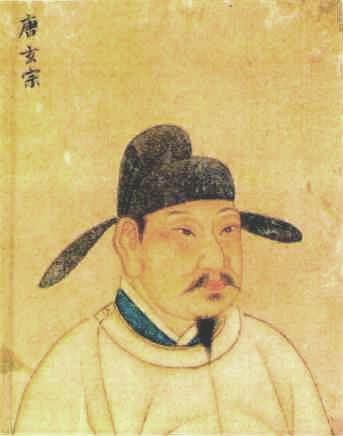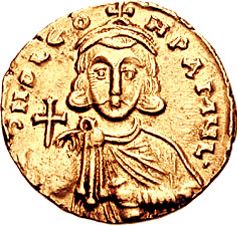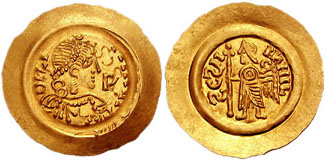|
730
__NOTOC__ Year 730 ( DCCXXX) was a common year starting on Sunday (link will display the full calendar) of the Julian calendar. The denomination 730 for this year has been used since the early medieval period, when the Anno Domini calendar era became the prevalent method in Europe for naming years. Events By place Europe * King Liutprand contracts an alliance with Eutychius, exarch of Ravenna, and agrees to support him in his attack on Rome, while subjugating the independent southern Lombard duchies of Benevento and Spoleto. * Tiberius Petasius proclaims himself emperor in Tuscia. Eutychius defeats him with the support of Pope Gregory II, and Tiberius is killed in Monterano, with his head sent to the Byzantine emperor Leo III as a gift. * Charles Martel defeats the last independent dukedom of Alamannia, and incorporates it into the Frankish Empire. He also launches raids on the Saxons beyond the Rhine. Arabian Empire * September - October – Umayyad forces sac ... [...More Info...] [...Related Items...] OR: [Wikipedia] [Google] [Baidu] |
Tiberius Petasius
Tiberius Petasius was a Byzantine usurper in Italy 730/731. History Very little of Tiberius life is known, other than that he was born Petasius, and that he revolted against the Byzantine Emperor Leo III the Isaurian () in either 730 or 731, in Tuscia, Italy, taking the regnal name Tiberius. It is possible that he was acclaimed as emperor by local Italian assemblies, who subsequently lost heart when the rebellion of Agallianos Kontoskeles in Greece was crushed. Tiberius gained the allegiance of several towns near Tuscia, including Castrum Manturianense (identified by the historian Ludovico Muratori as modern-day Barbarano Romano), Blera, and Luna (modern-day location unknown, but likely not the Luna in northern Etruria); Tiberius based himself out of Castrum Manturianense. The Exarch of Ravenna, Eutychius (), was sent to suppress Tiberius revolt. Eutychius was short on manpower, thus Pope Gregory II (), who did not support Leo III, but opposed the creation of rival emperors, sent ... [...More Info...] [...Related Items...] OR: [Wikipedia] [Google] [Baidu] |
Charles Martel
Charles Martel ( – 22 October 741) was a Frankish political and military leader who, as Duke and Prince of the Franks and Mayor of the Palace, was the de facto ruler of Francia from 718 until his death. He was a son of the Frankish statesman Pepin of Herstal and Pepin's mistress, a noblewoman named Alpaida. Charles, also known as "The Hammer" (in Old French, ''Martel''), successfully asserted his claims to power as successor to his father as the power behind the throne in Frankish politics. Continuing and building on his father's work, he restored centralized government in Francia and began the series of military campaigns that re-established the Franks as the undisputed masters of all Gaul. According to a near-contemporary source, the ''Liber Historiae Francorum'', Charles was "a warrior who was uncommonly ..effective in battle". Martel gained a very consequential victory against an Umayyad invasion of Aquitaine at the Battle of Tours, at a time when the Umayyad Caliphate ... [...More Info...] [...Related Items...] OR: [Wikipedia] [Google] [Baidu] |
Leo III The Isaurian
Leo III the Isaurian ( gr, Λέων ὁ Ἴσαυρος, Leōn ho Isauros; la, Leo Isaurus; 685 – 18 June 741), also known as the Syrian, was Byzantine Emperor from 717 until his death in 741 and founder of the Isaurian dynasty. He put an end to the Twenty Years' Anarchy, a period of great instability in the Byzantine Empire between 695 and 717, marked by the rapid succession of several emperors to the throne. He also successfully defended the Empire against the invading Umayyads and forbade the veneration of icons. Early life Of Syrian extraction, Leo was born in Germanikeia, Commagene (modern Kahramanmaraş in Turkey). His original name was Konon ( gr, Κόνων; la, Conon or ''Cononus''). Some, including the Byzantine chronicler Theophanes, have claimed that Konon's family had been resettled in Thrace, where he entered the service of Emperor Justinian II, when the latter was advancing on Constantinople with an army of loyalist followers, and horsemen provided by Terve ... [...More Info...] [...Related Items...] OR: [Wikipedia] [Google] [Baidu] |
Francia
Francia, also called the Kingdom of the Franks ( la, Regnum Francorum), Frankish Kingdom, Frankland or Frankish Empire ( la, Imperium Francorum), was the largest post-Roman barbarian kingdom in Western Europe. It was ruled by the Franks during late antiquity and the Early Middle Ages. After the Treaty of Verdun in 843, West Francia became the predecessor of France, and East Francia became that of Germany. Francia was among the last surviving Germanic kingdoms from the Migration Period era before its partition in 843. The core Frankish territories inside the former Western Roman Empire were close to the Rhine and Meuse rivers in the north. After a period where small kingdoms interacted with the remaining Gallo-Roman institutions to their south, a single kingdom uniting them was founded by Clovis I who was crowned King of the Franks in 496. His dynasty, the Merovingian dynasty, was eventually replaced by the Carolingian dynasty. Under the nearly continuous campaigns of Pep ... [...More Info...] [...Related Items...] OR: [Wikipedia] [Google] [Baidu] |
Umayyad Caliphate
The Umayyad Caliphate (661–750 CE; , ; ar, ٱلْخِلَافَة ٱلْأُمَوِيَّة, al-Khilāfah al-ʾUmawīyah) was the second of the four major caliphates established after the death of Muhammad. The caliphate was ruled by the Umayyad dynasty ( ar, ٱلْأُمَوِيُّون, ''al-ʾUmawīyūn'', or , ''Banū ʾUmayyah'', "Sons of Umayyah"). Uthman ibn Affan (r. 644–656), the third of the Rashidun caliphs, was also a member of the clan. The family established dynastic, hereditary rule with Muawiya ibn Abi Sufyan, long-time governor of Greater Syria, who became the sixth caliph after the end of the First Fitna in 661. After Mu'awiyah's death in 680, conflicts over the succession resulted in the Second Fitna, and power eventually fell into the hands of Marwan I from another branch of the clan. Greater Syria remained the Umayyads' main power base thereafter, with Damascus serving as their capital. The Umayyads continued the Muslim conquests, incorpo ... [...More Info...] [...Related Items...] OR: [Wikipedia] [Google] [Baidu] |
Alamannia
Alamannia, or Alemannia, was the kingdom established and inhabited by the Alemanni, a Germanic peoples, Germanic tribal confederation that had broken through the Roman ''Upper Germanic Limes, limes'' in 213. The Alemanni expanded from the Main (river), Main River basin during the 3rd century and raided Roman provinces and settled on the left bank of the Rhine River from the 4th century. Ruled by independent Germanic king, tribal kings during the 4th and the 5th centuries, Alamannia lost its independence and became a duchy of the Frankish Empire in the 6th century. As the Holy Roman Empire started to form under King Conrad I of Germany, Conrad I of East Francia (reigning 911 to 918), the territory of Alamannia became the Duchy of Swabia in 915. Scribes often used the term ''Swabia, Suebia'' interchangeably with ''Alamannia'' in the 10th to the 12th centuries. The territory of Alamannia as it existed from the 7th to 9th centuries centred on Lake Constance and included the High Rh ... [...More Info...] [...Related Items...] OR: [Wikipedia] [Google] [Baidu] |
Saxons
The Saxons ( la, Saxones, german: Sachsen, ang, Seaxan, osx, Sahson, nds, Sassen, nl, Saksen) were a group of Germanic * * * * peoples whose name was given in the early Middle Ages to a large country (Old Saxony, la, Saxonia) near the North Sea coast of northern Germania, in what is now Germany. In the late Roman Empire, the name was used to refer to Germanic coastal raiders, and as a name similar to the later "Viking". Their origins are believed to be in or near the German North Sea coast where they appear later, in Carolingian times. In Merovingian times, continental Saxons had been associated with the activity and settlements on the coast of what later became Normandy. Their precise origins are uncertain, and they are sometimes described as fighting inland, coming into conflict with the Franks and Thuringians. There is possibly a single classical reference to a smaller homeland of an early Saxon tribe, but its interpretation is disputed. According to this proposal, the S ... [...More Info...] [...Related Items...] OR: [Wikipedia] [Google] [Baidu] |
Pope Gregory II
Pope Gregory II ( la, Gregorius II; 669 – 11 February 731) was the bishop of Rome from 19 May 715 to his death.Mann, Horace. "Pope St. Gregory II." The Catholic Encyclopedia Vol. 6. New York: Robert Appleton Company, 1909. 18 September 2017 His defiance of Emperor as a result of the in the Eastern Empire prepared the way for a long series of revolts, schisms, and civil wars that eventually led to the establishment of the [...More Info...] [...Related Items...] OR: [Wikipedia] [Google] [Baidu] |
Liutprand, King Of The Lombards
Liutprand was the king of the Lombards from 712 to 744 and is chiefly remembered for his multiple phases of law-giving, in fifteen separate sessions from 713 to 735 inclusive, and his long reign, which brought him into a series of conflicts, mostly successful, with most of Italy. He is often regarded as the most successful Lombard monarch, notable for the Donation of Sutri in 728, which was the first accolade of sovereign territory to the Papacy. Early life Liutprand's life began inauspiciously. His father was driven to exile among the Bavarians, his older brother Sigipert was blinded by Aripert II, king of the Lombards, and his mother Theodarada and sister Aurona were mutilated (their noses and ears were cut off). Liutprand was spared only because his youth made him appear harmless, described as adolescens in Paul the Deacon's ''Historia Langobardorum'' (Book VI, xxii), suggesting that he was 'probably older than 19 but still in his twenties'. He was released from Aripert II's ... [...More Info...] [...Related Items...] OR: [Wikipedia] [Google] [Baidu] |
Charsianon
Charsianon ( el, Χαρσιανόν) was the name of a Byzantine fortress and the corresponding theme (a military-civilian province) in the region of Cappadocia in central Anatolia (modern Turkey). History The fortress of Charsianon (Greek: Χαρσιανόν κάστρον, ''Charsianon kastron''; Arabic: ''Qal'e-i Ḥarsanōs'') is first mentioned in 638, during the first wave of the Muslim conquests, and was allegedly named after a general of Justinian I named Charsios.. The fortress is now identified with the ruins of Muşali Kale in the Akdağmadeni district in Yozgat Province). The Arabs first seized it in 730, and it remained a hotly contested stronghold during the next century of Byzantine–Arab warfare. During the 8th century, it belonged to the Armeniac Theme and was the seat of a military and territorial district (''tourma''). In the early 9th century, the fortress became the centre of a '' kleisoura'', a separately administered fortified frontier district. Sometime ... [...More Info...] [...Related Items...] OR: [Wikipedia] [Google] [Baidu] |
Julian Calendar
The Julian calendar, proposed by Roman consul Julius Caesar in 46 BC, was a reform of the Roman calendar. It took effect on , by edict. It was designed with the aid of Greek mathematicians and astronomers such as Sosigenes of Alexandria. The calendar became the predominant calendar in the Roman Empire and subsequently most of the Western world for more than 1,600 years until 1582, when Pope Gregory XIII promulgated a minor modification to reduce the average length of the year from 365.25 days to 365.2425 days and thus corrected the Julian calendar's drift against the solar year. Worldwide adoption of this revised calendar, which became known as the Gregorian calendar, took place over the subsequent centuries, first in Catholic countries and subsequently in Protestant countries of the Western Christian world. The Julian calendar is still used in parts of the Eastern Orthodox Church and in parts of Oriental Orthodoxy as well as by the Berbers. The Julian calenda ... [...More Info...] [...Related Items...] OR: [Wikipedia] [Google] [Baidu] |
Common Year Starting On Sunday
A common year starting on Sunday is any non-leap year (i.e. a year with 365 days) that begins on Sunday, January 1, 1 January, and ends on Sunday, December 31, 31 December. Its dominical letter hence is A. The most recent year was 2017 and the next one will be 2023 in the Gregorian calendar, or, likewise, 2018 and 2029 in the obsolete Julian calendar, see #Applicable years, below for more. Any common year that starts on Sunday, Common year starting on Monday, Monday or Common year starting on Tuesday, Tuesday has two Friday the 13ths: those two in this common year January 13, occur in January and October 13, October. In this common year, Martin Luther King Jr. Day is on January 16, Valentine's Day is on a Tuesday, Presidents Day is on February 20, Saint Patrick's Day is on a Friday, Memorial Day is on May 29, Juneteenth is on a Monday, Independence Day (United States), U.S. Independence Day and Halloween are on a Tuesday, Labor Day is on September 4, Thanksgiving is on November 2 ... [...More Info...] [...Related Items...] OR: [Wikipedia] [Google] [Baidu] |







_(cropped).jpg)